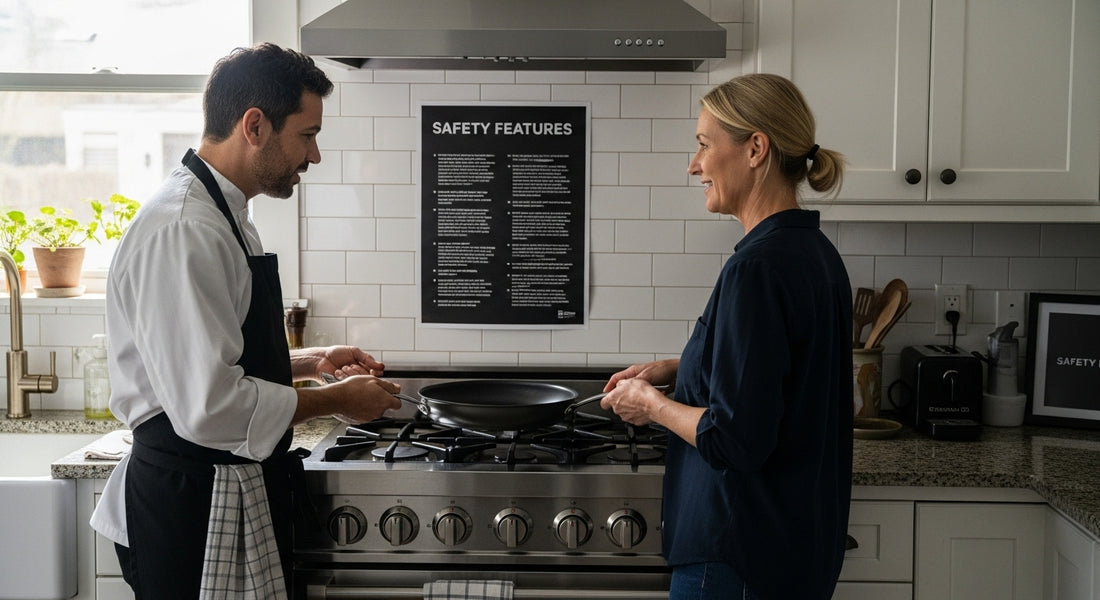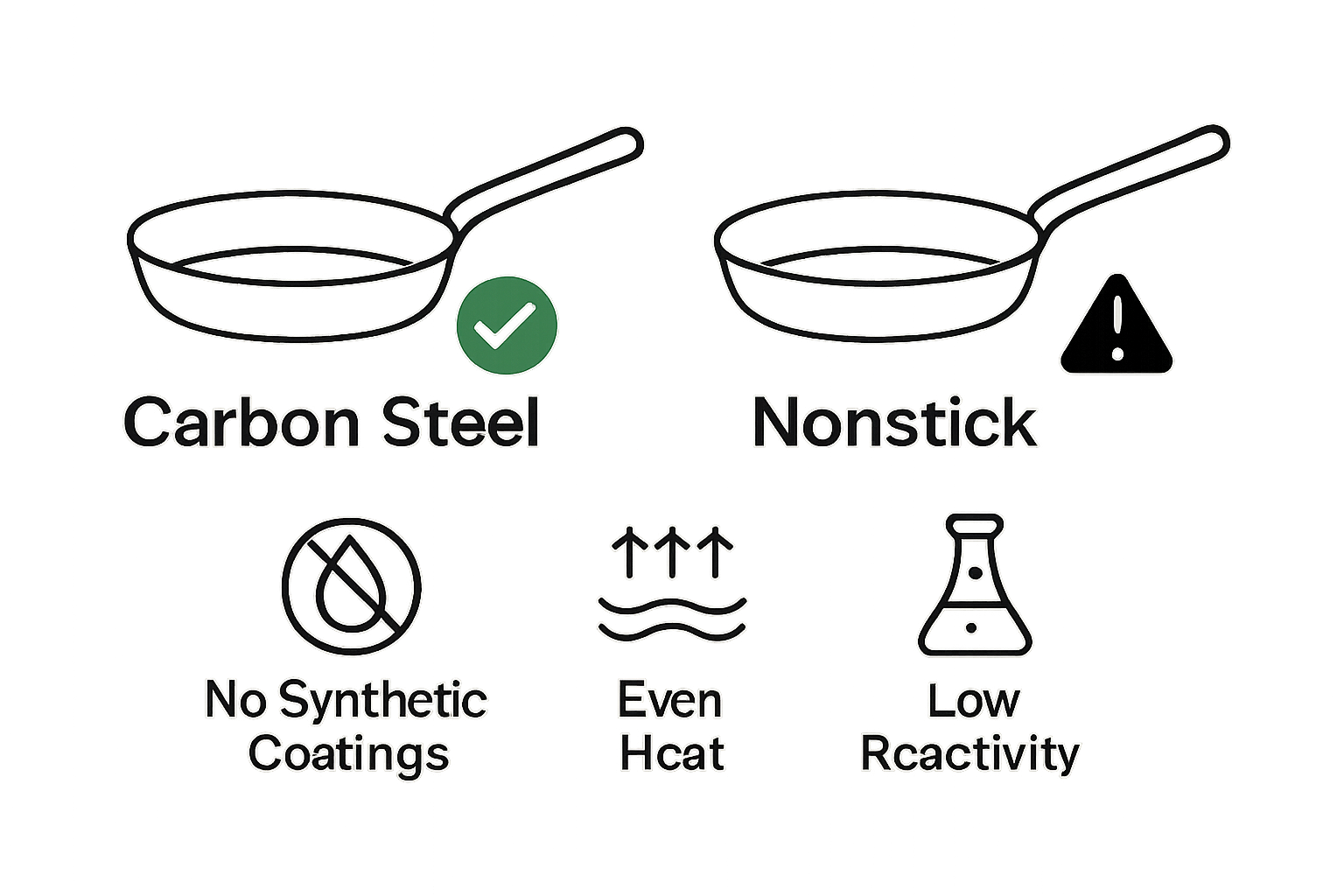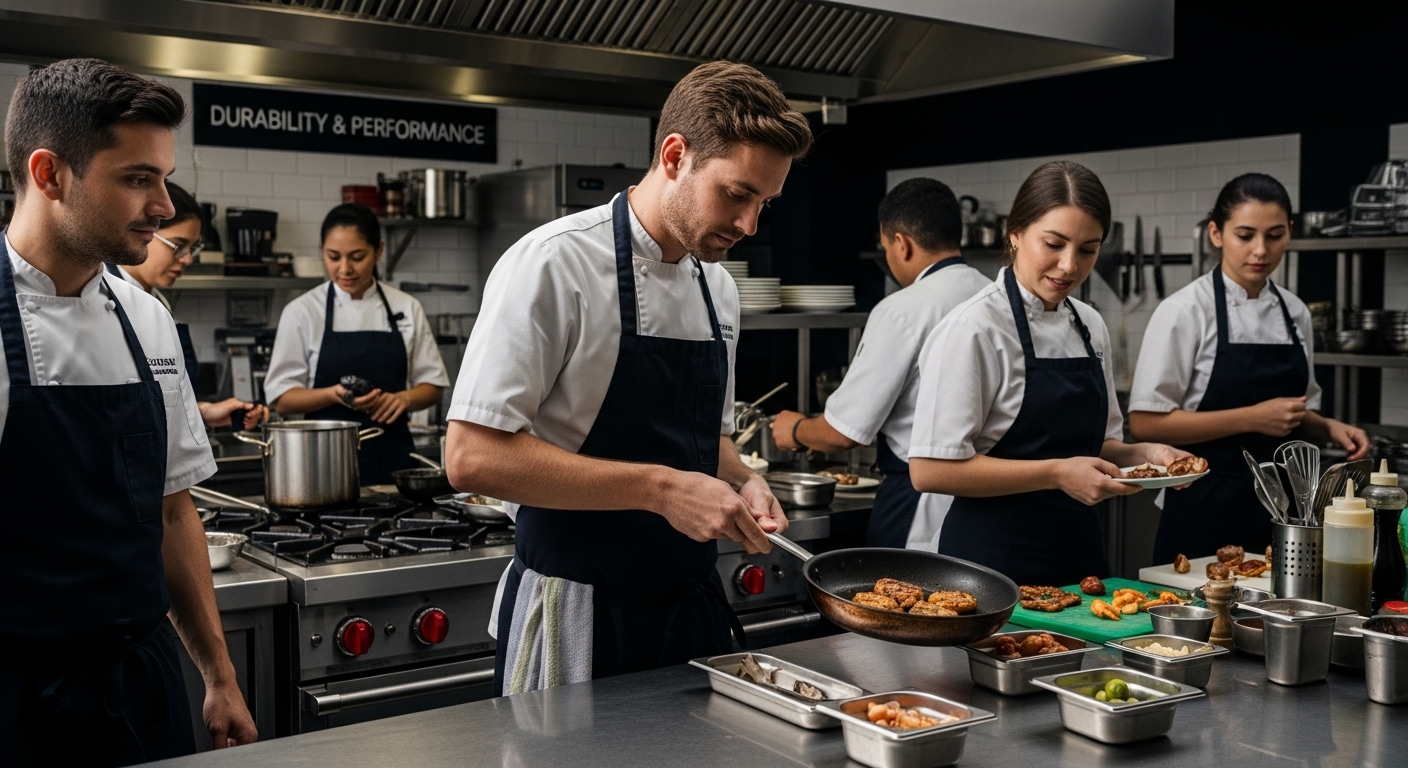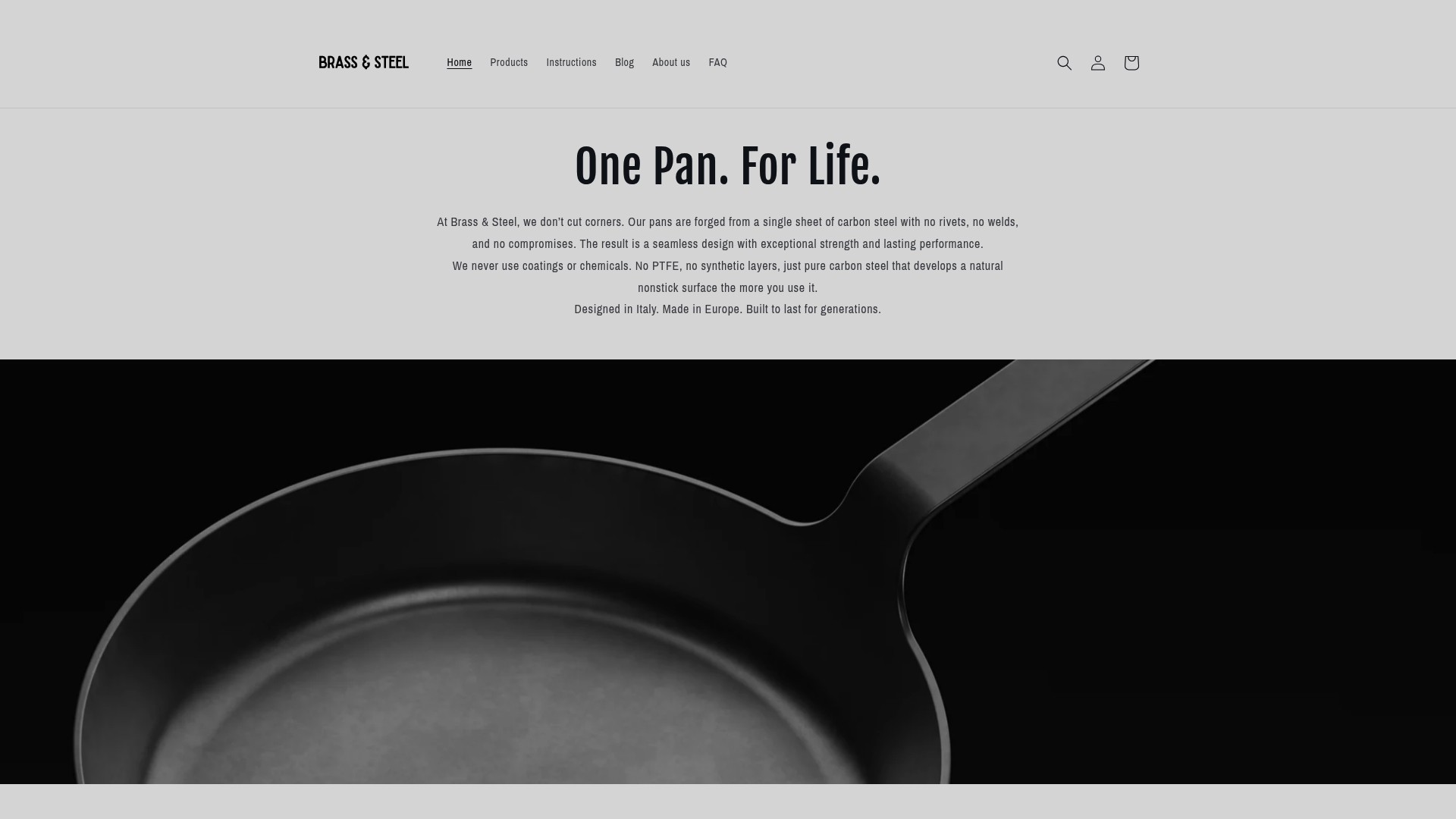
Understanding Carbon Steel Safety Features in Cooking
Share
Carbon steel might look like any other metal, but its secret lies in the details. A subtle shift in its makeup with just 0.05% to 2.1% carbon content transforms basic iron into a culinary powerhouse. It is easy to overlook at first, yet this unassuming alloy can outperform flashier pans and become the favourite tool of chefs who know how to unlock its full potential.
Table of Contents
- What Is Carbon Steel And Its Unique Properties?
- Why Carbon Steel Safety Features Matter In Cooking
- How Carbon Steel Works In Culinary Settings
- Key Concepts Of Carbon Steel Maintenance And Safety
- Real-World Applications Of Carbon Steel For Chefs
Quick Summary
| Takeaway | Explanation |
|---|---|
| Carbon steel offers outstanding heat conductivity. | It distributes heat evenly, ensuring consistent cooking results across various culinary techniques. |
| Regular seasoning enhances carbon steel performance. | Seasoning creates a natural nonstick surface that improves with repeated use, contributing to superior cooking quality. |
| Chemical safety is a key advantage of carbon steel. | It avoids synthetic coatings, reducing the risk of harmful chemical exposure during cooking. |
| Carbon steel requires mindful maintenance practices. | Proper care, including controlled cleaning and regular seasoning, is essential to preserve its durability and functionality. |
| Versatile for various cooking techniques. | Carbon steel is suitable for high-temperature searing and delicate dishes, making it a favourite among professional chefs. |
What is Carbon Steel and Its Unique Properties?
Carbon steel represents a remarkable metal alloy that combines iron and carbon in a way that transforms its fundamental characteristics for cooking applications. Its precise composition typically ranges between 0.05% and 2.1% carbon content, creating a material that balances strength, durability, and exceptional thermal performance.
The Metallurgical Composition of Carbon Steel
At its core, carbon steel is an alloy where iron molecules are strategically enhanced with carbon atoms. This unique combination produces a material with extraordinary properties that distinguish it from other cookware metals. Learn more about carbon steel’s unique characteristics.
The key attributes of carbon steel include:
- Remarkable Heat Conductivity: Distributes temperature evenly across cooking surfaces
- Rapid Temperature Response: Quickly adjusts to temperature changes
- Natural Durability: Resists warping and maintains structural integrity
Performance Characteristics in Culinary Applications
Carbon steel exhibits extraordinary performance characteristics that make it a preferred choice for professional and home chefs. According to scientific research on metal alloys, the material’s molecular structure allows for superior heat transfer and retention.
Unlike alternative cookware materials, carbon steel develops a natural nonstick patina through seasoning. This process creates a protective layer that enhances cooking performance while preventing food from sticking. The seasoning improves with repeated use, making carbon steel cookware increasingly effective over time.
Chefs appreciate carbon steel for its versatility across different cooking techniques. Whether searing meats at high temperatures, slowly braising delicate sauces, or transitioning seamlessly from stovetop to oven, carbon steel delivers consistent and reliable performance.
The material’s ability to withstand extreme temperatures without degrading makes it a professional-grade cooking solution.
Below is a table comparing carbon steel with other common cookware materials, summarising their respective safety, performance, and maintenance characteristics as discussed in the article.
| Material | Composition | Safety Profile | Performance Traits | Maintenance Requirements |
|---|---|---|---|---|
| Carbon Steel | Iron with 0.05%-2.1% carbon | No synthetic coatings; low reactivity; minimal metal leaching | Superior heat conductivity and response | |
| Develops natural nonstick surface | Requires seasoning; avoid harsh detergents | |||
| Immediate drying needed | ||||
| Nonstick (PTFE/PFOA) | Aluminium/steel with PTFE/PFOA | Risk of toxic exposure at high temperatures | Easy nonstick out of box | |
| Vulnerable to scratching | Do not overheat | |||
| Hand wash recommended | ||||
| Stainless Steel | Iron, chromium, nickel | Generally safe; can leach nickel/chromium with acidity | Good heat retention | |
| Can be prone to sticking | No seasoning needed | |||
| Can use harsher detergents | ||||
| Cast Iron | Mostly iron, high carbon | Safe if seasoned; can leach iron | Excellent heat retention | |
| Slow to heat/respond | Needs frequent seasoning | |||
| Thorough drying to prevent rust | ||||
| Aluminium (uncoated) | Pure or alloyed aluminium | Can react with acidic foods; linked to potential health risks | Heats rapidly | |
| Bends easily | Hand wash | |||
| Avoid acidic dishes | ||||
| Its robust construction ensures long-term durability, transforming from a simple cooking tool into a potential family heirloom passed through generations of culinary enthusiasts. |
Why Carbon Steel Safety Features Matter in Cooking
In the culinary world, safety transcends mere cooking performance and enters the critical realm of health protection. Carbon steel emerges as a superior material that addresses multiple safety concerns inherent in traditional cookware manufacturing. Learn more about carbon steel health benefits.
Chemical Safety and Material Integrity
Modern cooking demands materials that do not compromise human health through toxic chemical interactions. Carbon steel stands distinctly apart from conventional cookware by eliminating potentially harmful synthetic coatings. According to research on environmental health standards, the material offers remarkable protection against metal leaching and contamination risks.
Key safety advantages include:

- No Synthetic Coatings: Eliminates exposure to PFOA and PTFE chemicals
- Natural Composition: Contains only iron and carbon molecules
- Low Reactivity: Minimal interaction with cooking acids and ingredients
Temperature Stability and Cooking Performance
Carbon steel demonstrates exceptional temperature stability, which directly contributes to cooking safety. Unlike alternative materials that might degrade or release toxic substances under high heat, carbon steel maintains structural integrity across extreme cooking conditions.
The material’s thermal conductivity ensures even heat distribution, reducing potential hot spots that could cause uneven cooking or food burning. This characteristic is particularly crucial when preparing delicate dishes requiring precise temperature control.
Professional chefs appreciate carbon steel not just for its performance but for its inherent safety profile. The material’s natural seasoning process creates a protective layer that enhances both cooking quality and nutritional integrity, transforming each meal preparation into a safer culinary experience.
How Carbon Steel Works in Culinary Settings
Carbon steel operates through a sophisticated mechanism that transforms cooking performance, blending material science with culinary expertise. Discover more about choosing the right cookware.
The Seasoning Process
Seasoning represents the cornerstone of carbon steel’s unique functionality. According to nutrition experts, this process creates a natural protective layer that enhances cooking performance and prevents corrosion.
The seasoning mechanism involves:
- Polymerization: Heating oil to create a molecular bond with pan surface
- Surface Transformation: Building a protective carbon layer
- Ongoing Enhancement: Improving nonstick properties with each use
Thermal Dynamics and Cooking Interaction
Carbon steel exhibits exceptional thermal conductivity, allowing rapid and uniform heat distribution. This characteristic enables precise temperature control and consistent cooking results across various culinary techniques.
The material’s molecular structure permits quick temperature adjustments, making it ideal for techniques requiring immediate heat responsiveness. Searing, sautéing, and rapid cooking methods benefit significantly from carbon steel’s unique thermal properties.
Professional chefs value carbon steel for its ability to develop a naturally nonstick surface through repeated use. Unlike synthetic coatings, this organic seasoning layer grows more effective with each cooking session, creating a symbiotic relationship between the cookware and the cooking process.
Key Concepts of Carbon Steel Maintenance and Safety
Maintaining carbon steel cookware requires understanding its unique material properties and implementing strategic care practices. Learn about preventing rust and warping to ensure long-term performance and safety.
Essential Care and Preservation Techniques
Carbon steel demands a nuanced approach to maintenance that protects its structural integrity and cooking performance. According to health prevention research, proper care ensures minimal iron release and optimal cookware longevity.
Critical maintenance considerations include:
- Regular Seasoning: Protects against rust and enhances nonstick properties
- Controlled Cleaning: Avoiding harsh detergents and prolonged water exposure
- Systematic Drying: Immediate and thorough moisture removal after washing
Identifying and Preventing Potential Risks
Recognizing potential maintenance challenges is crucial for preserving carbon steel cookware. Severe rusting or surface deterioration can compromise both cooking performance and safety, necessitating proactive monitoring and intervention.
Professional chefs understand that carbon steel requires a symbiotic relationship between user and cookware.
The following table organises the essential care and preservation techniques for carbon steel identified in the maintenance section, providing a clear reference for safe and effective pan upkeep.
| Maintenance Practice | Purpose | Key Recommendation |
|---|---|---|
| Regular Seasoning | Protects against rust; enhances nonstick surface | Heat oil in pan regularly to maintain protective layer |
| Controlled Cleaning | Preserves seasoning, prevents corrosion | Use minimal soap; avoid harsh detergents or scrubbing |
| Systematic Drying | Prevents rust formation | Dry immediately and thoroughly after washing |
| Avoid Prolonged Soaking | Reduces risk of rust and warping | Never leave pan soaking in water |
| Oil Application Post-Use | Maintains seasoning and prevents oxidation | Apply thin layer of oil after cleaning |
| The material responds positively to consistent, mindful maintenance practices that respect its fundamental metallurgical characteristics. By understanding its thermal dynamics and susceptibility to environmental factors, users can prevent common degradation issues and maintain peak cooking performance. |
Unlike synthetic cookware, carbon steel rewards attentive care with improved cooking characteristics and a naturally developing protective surface that grows more effective with each use.
Real-World Applications of Carbon Steel for Chefs
Carbon steel transcends traditional cookware limitations, offering professional chefs a versatile and dynamic cooking medium that adapts to sophisticated culinary techniques. Learn more about advanced cooking methods.
Professional Kitchen Performance
According to engineering standards for cookware, carbon steel demonstrates exceptional capabilities across various cooking methodologies. Its unique metallurgical composition enables chefs to execute precise temperature-sensitive techniques with remarkable consistency.
Key professional applications include:
- High-Temperature Searing: Perfect for creating caramelized meat surfaces
- Rapid Heat Responsiveness: Enables instant temperature adjustments
- Versatile Cooking Techniques: Seamless transitions between stovetop and oven
Culinary Technique Specialisation
Professional kitchens value carbon steel for its extraordinary adaptability across different cooking environments. From delicate French techniques to robust industrial kitchen requirements, carbon steel provides unparalleled performance that synthetic materials cannot match.
The material’s thin yet robust construction allows for superior heat distribution, enabling chefs to achieve nuanced cooking results. Its natural nonstick properties develop through consistent use, creating a cooking surface that improves with each culinary creation. Unlike alternative cookware, carbon steel rewards skill and technique, becoming more effective as chefs build their relationship with the pan.
Chefs appreciate carbon steel not just as a cooking tool, but as a professional instrument that responds to their expertise, transforming raw ingredients into culinary masterpieces with precision and consistency.

Explore Safer Cooking With Brass & Steel Carbon Steel Pans
If the health and safety benefits of carbon steel cookware have caught your attention, now is the perfect moment to upgrade your kitchen. Many home cooks worry about hazardous chemicals in coated pans, or feel unsure if their cookware can truly deliver both safety and durability. At Brass & Steel, we address these concerns by offering professional-grade carbon steel pans that are precision-forged from a single sheet. Our pans are free from PTFE and PFOA, ensuring a naturally safe nonstick surface built by seasoning—exactly as discussed in our article on carbon steel safety features. Discover our Carbon Steel Collection to see what sets our products apart for real peace of mind in your kitchen.

Take the step towards healthier, chemical-free cooking today. Visit Brass & Steel to learn more about our rigorous standards and find the right carbon steel pan for you. Make your next meal safer and experience cookware that truly lasts—this is heirloom quality, designed for cooks who care about both results and well-being.
Frequently Asked Questions
What are the safety benefits of using carbon steel cookware?
Carbon steel cookware is free from synthetic coatings, which eliminates exposure to harmful chemicals like PFOA and PTFE. Its natural composition consists only of iron and carbon, providing a low reactivity with cooking acids.
How does the seasoning process improve the safety of carbon steel?
The seasoning process forms a protective layer that enhances both cooking performance and safety. This organic layer helps to prevent corrosion and creates a naturally nonstick surface, reducing the chances of food sticking and burning.
Can carbon steel cookware withstand high temperatures safely?
Yes, carbon steel can withstand extreme temperatures without degrading. Its exceptional thermal stability ensures consistent cooking performance while maintaining safety by preventing the release of toxic substances under high heat.
How do I maintain my carbon steel cookware to ensure its safety and effectiveness?
Regular seasoning, controlled cleaning without harsh detergents, and systematic drying after washing are essential practices to maintain your carbon steel cookware. Proper care helps prevent rust and preserves its natural nonstick properties.
Recommended
- Health & Safety Benefits of Carbon Steel Pans – Brass & Steel
- Is a Carbon Steel Pan the Right Choice for You? – Brass & Steel
- 10 Facts You Never Knew About Carbon Steel Pans – Brass & Steel
- How to switch from Nonstick to Carbon Steel cookware (beginner’s guide – Brass & Steel
- Carbon Steel Properties for Gauteng Industries 2025 - Genesis Steel